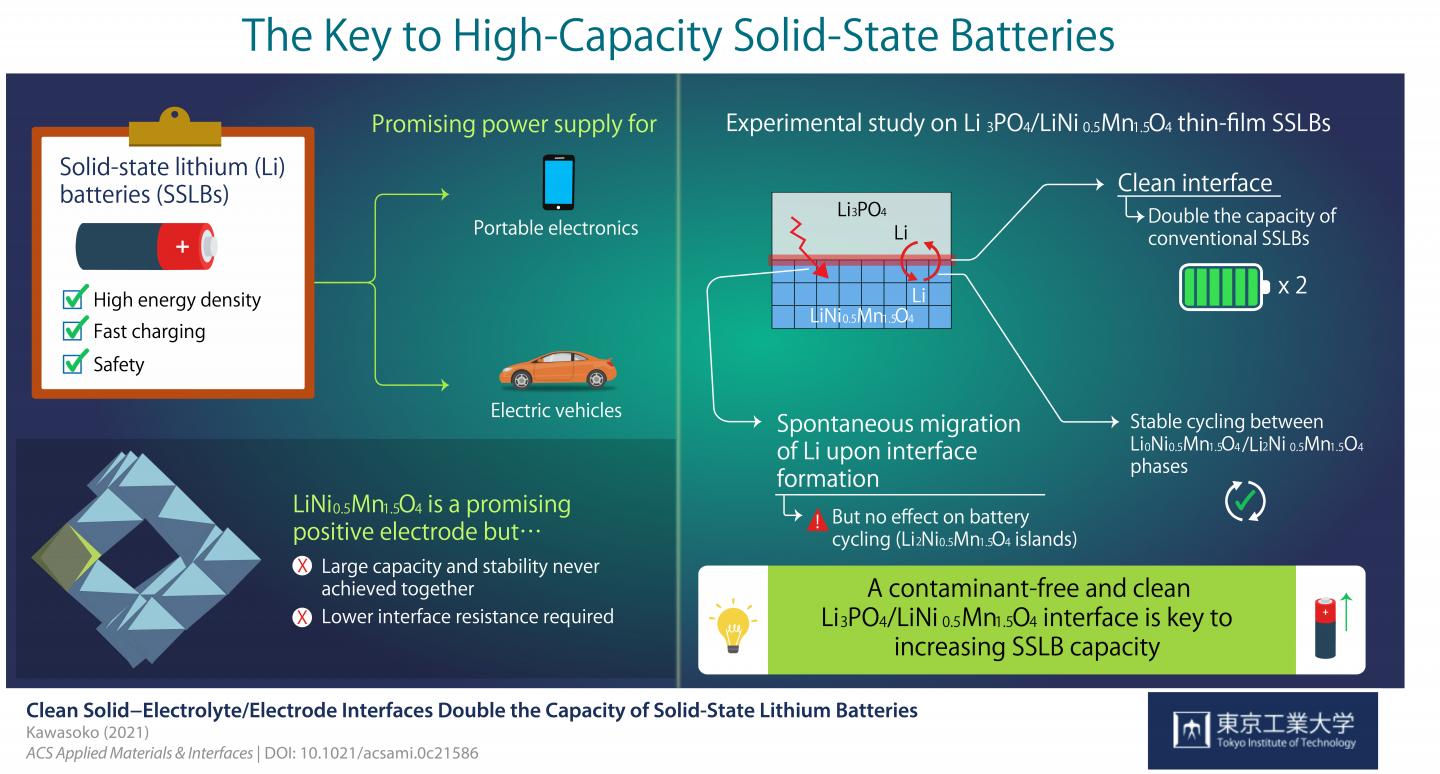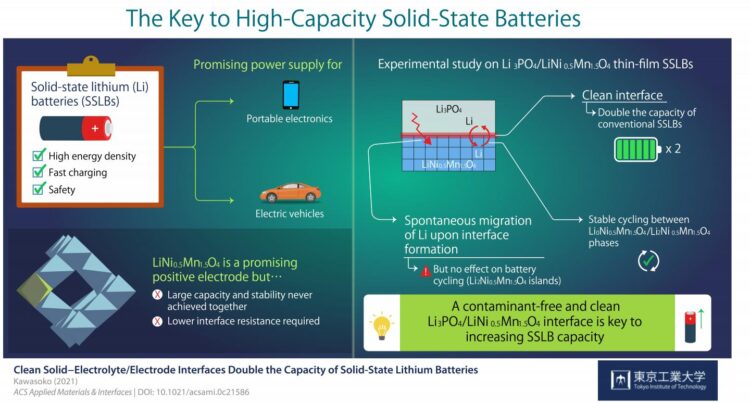
Credit: Taro Hitosugi
Scientists at Tokyo Institute of Technology (Tokyo Tech), Tohoku University, National Institute of Advanced Industrial Science and Technology, and Nippon Institute of Technology, demonstrated by experiment that a clean electrolyte/electrode interface is key to realizing high-capacity solid-state lithium batteries. Their findings could pave the way for improved battery designs with increased capacity, stability, and safety for both mobile devices and electric vehicles.
Liquid lithium-ion batteries are everywhere, being found in the majority of everyday mobile devices. While they possess a fair share of advantages, liquid-based batteries carry notable risks as well. This has become clear to the public in recent years after reports of smartphones bursting into flames due to design errors that caused the battery’s liquid electrolyte to leak and catch fire.
Other disadvantages such as fabrication cost, durability, and capacity, led scientists to look into a different technology: solid-state lithium batteries (SSLBs). SSLBs comprise solid electrodes and a solid electrolyte that exchange lithium (Li) ions during charging and discharging. Their higher energy density and safety make SSLBs very powerful sources.
However, there are still many technical challenges preventing SSLBs’ commercialization. For the current study, researchers conducted a series of experiments and gained insight that could take SSLBs’ performance to the next level. Professor Taro Hitosugi from Tokyo Tech, who led the study, explains their motivation: “LiNi0.5Mn1.5O4 (LNMO) is a promising material for the positive electrode of SSLBs because it can generate comparatively higher voltages. In this study, we showed battery operations at 2.9 and 4.7 V, and simultaneously achieved large capacity, stable cycling, and low resistance at the electrolyte/electrode interface.”
Previous studies had hinted that producing a clean electrolyte/electrode interface was essential to achieve low interface resistance and fast charging in LNMO-based SSLBs. Scientists also noted that Li ions spontaneously migrated from Li3PO4 (LPO) electrolyte to the LNMO layer upon fabrication, forming a Li2Ni0.5Mn1.5O4 (L2NMO) phase in LNMO with unknown distribution and impact on battery performance.
The team investigated what the L2NMO phase was like, analyzing the changes in crystalline structure between the Li0Ni0.5Mn1.5O4 (L0NMO) and L2NMO phases during charging and discharging. They also studied the initial distribution of L2NMO at clean LPO/LNMO interfaces fabricated in a vacuum, as well as the effect of electrode thickness.
Strikingly, the clean interface facilitated the intercalation and deintercalation of Li during charging and discharging of the SSLBs. As a result, the capacity of SSLBs with a clean interface was twice that of conventional LNMO-based batteries. Moreover, this study marked the first time stable reversible reactions were found between the L0NMO and L2NMO phases in SSLBs.
Assistant Professor Hideyuki Kawasoko of Tohoku University and lead author of the study remarked, “Our findings indicate that the formation of a contamination-free, clean LPO/LNMO interface is key to increasing the capacity of SSLBs while ensuring low interface resistance for fast charging.”
Aside from mobile devices, SSLBs could find a home in electric cars, for which cost and battery durability act as major barriers for widespread commercialization. The results of this study provide important insight for future SSLB designs and pave the way for a transition away from fossil fuels and towards more ecofriendly ways of transportation. Keep an eye out for the advent of SSLBs!
###
About Tokyo Institute of Technology
Tokyo Tech stands at the forefront of research and higher education as the leading university for science and technology in Japan. Tokyo Tech researchers excel in fields ranging from materials science to biology, computer science, and physics. Founded in 1881, Tokyo Tech hosts over 10,000 undergraduate and graduate students per year, who develop into scientific leaders and some of the most sought-after engineers in industry. Embodying the Japanese philosophy of “monotsukuri,” meaning “technical ingenuity and innovation,” the Tokyo Tech community strives to contribute to society through high-impact research.
https:/
About Tohoku University
For more than a century, Tohoku University has been consistently ranked amongst the top academic institutions in Japan. Its research achievements and contributions, coupled with its wide network of collaborative partners, led to it being one of the first institutions to be conferred the status of a Designated National University by the Japanese government in June 2017. The university prides itself in its community engagement and the transformational impacts its research has on society at large. In the aftermath of the 2011 Great East Japan Earthquake, Tohoku University pioneered research in next-generation medicine and disaster science, giving local and global communities the necessary tools and knowledge to fight illnesses and be better prepared for natural disasters.
http://www.
National Institute of Advanced Industrial Science & Technology (AIST)
AIST is the largest public research institute established in 1882 in Japan. The research fields of AIST covers all industrial sciences, e.g., electronics, material science, life science, metrology, etc. Our missions are bridging the gap between basic science and industrialization and solving social problems facing the world. we prepare several open innovation platforms to contribute to these missions, where researchers in companies, university professors, graduated students, as well as AIST researchers, get together to achieve our missions. The open innovation platform established recently is The Global Zero Emission Research Center which contributes to achieving a zero-emission society collaborating with foreign researches.
https:/
About Nippon Institute of Technology
Nippon Institute of Technology celebrated its 50th anniversary in 2017. Our mission was, and still is, to raise outstanding engineers who can utilize theoretical concepts of engineering in the frontline of industry. We developed our unique teaching method using “practical engineering”, making the best use of what students had learnt in technical high school.
https:/
Media Contact
Emiko Kawaguchi
[email protected]
Original Source
https:/
Related Journal Article
http://dx.





